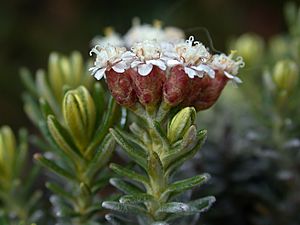Ozothamnus ledifolius facts for kids
Quick facts for kids Ozothamnus ledifolius |
|
|---|---|
 |
|
| Ozothamnus ledifolius by Robert Wiltshire (UTAS), TAS | |
| Scientific classification | |
| Kingdom: | |
| (unranked): | |
| Order: | |
| Family: | |
| Tribe: |
Gnaphalieae
|
| Genus: |
Ozothamnus
|
| Species: |
O. ledifolius
|
| Binomial name | |
| Ozothamnus ledifolius |
|
Ozothamnus ledifolius is a type of shrub that belongs to the Asteraceae family, also known as the daisy family. It is one of 54 species in the Ozothamnus group.
This plant was first brought to attention in 1929 by Harold Frederick Comber, an English plant expert. He found it on mountains in Tasmania, Australia, collecting seeds from high up, around 4,000 feet (1,200 meters).
Contents
What's in a Name?
The name Ozothamnus was first given by a Scottish botanist named Robert Brown. The specific name ledifolius was first described by Augustin Pyramus de Candolle. Later, Joseph Dalton Hooker helped classify it in the modern plant system.
This plant has a few common names. It's often called Kerosene Bush because it has a strong, spicy smell, especially when the weather is warm. It's also very easy to catch fire, just like kerosene! In different parts of Tasmania, people also call it the mountain everlasting bush or mountain spice.
Plant Family and Features
All plants in the Ozothamnus group are shrubs. Out of the 54 species, 44 are found only in Australia. Ozothamnus is part of the daisy family, which is a large group of flowering plants. This means Ozothamnus ledifolius has special types of flowers that are grouped together. It also has two seed leaves when it first sprouts, which is typical for its plant group.
How it Grows
Size and Appearance
Ozothamnus ledifolius is a slow-growing shrub that usually reaches about 1 to 2 meters (3 to 6 feet) tall. It often grows into a dense, rounded shape with upright stems that are yellowish-green. Younger stems can feel soft and fuzzy. This plant is tough and can handle both dry weather and very cold frost.
Leaves
The leaves of Ozothamnus ledifolius are always green. They are long and narrow, shiny on top, and fuzzy underneath. Their edges curl inwards. In summer, the leaves release a peppery smell because of special natural oils they contain.
Flowers
The flowers of Ozothamnus ledifolius are small and white. They start as orange buds and open up into white flower heads in late spring. These flowers grow in tight clusters on longer stalks, forming a rounded shape. They are arranged in a pattern that spreads out like rays. The sweet smell of the flowers helps attract Bees, Birds, and butterflies.
Fruits
After flowering, Ozothamnus ledifolius produces a type of fruit called an achene. This is a small, dry fruit that holds just one seed and does not open to release it. The seeds can stay dormant (asleep) for up to two months. Once they start to grow, it takes about two to four weeks for them to sprout.
Where it Lives
Ozothamnus ledifolius is a plant that is native only to Tasmania. It often grows in high, open areas like alpine heaths, where it forms cushion-like shapes. You can also find it in rock gardens.
One well-known place to see it is near the top of Mount Wellington in Hobart. It's also found in the Derwent Valley, especially at Mount Field National Park, along the Lake Belcher track.
Here are some places where Ozothamnus ledifolius has been found:
| Place | Latitude | Longitude |
|---|---|---|
| Huon Valley, South Port | -43.417 | 146.967 |
| Tasman | -43.179 | 147.831 |
| Hobart, Mt. Wellington | -42.882 | 147.233 |
| Derwent Valley, Mt. Field National Park (Lake Belcher track) | -42.667 | 146.55 |
| Central Highlands, Millers Bluff, Great Western Tiers | -41.95 | 147.17 |
| Northern Midlands | -41.839 | 146.975 |
| Meander Valley | -41.729 | 146.671 |
| Kentish, Crater Lake | -41.667 | 145.93 |
| Break O'Day | -41.349 | 147.870 |
Growing Conditions
Ozothamnus ledifolius is very good at using sunlight for photosynthesis (making its own food). However, it prefers places where the sun isn't directly overhead all day. It grows best in a sunny, sheltered spot.
For healthy growth, it needs soil that is acidic, sandy, always a little moist, and drains water well. Other common weeds can make it harder for Ozothamnus ledifolius to grow. It also doesn't like too much phosphorus in the soil.
Conservation Status
The number of Ozothamnus ledifolius plants in Tasmania is quite low. It is mostly found in specific areas like Mt. Wellington Park.
How People Use It
Plants from the daisy family are often grown for their beauty. Ozothamnus ledifolius is used in gardens, especially in coastal areas, on slopes, and banks. It can also be planted to create neat borders or edges in a garden. Trimming the stems helps the plant grow bushier and fuller.

